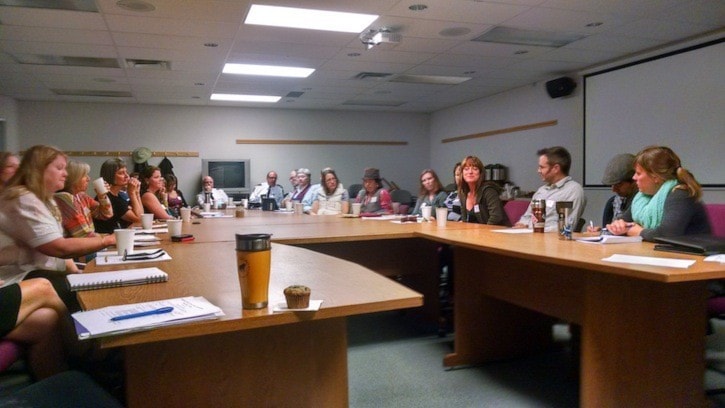Fourth in a series on the Street Culture Collaborative
The Nelson Street Culture Collaborative has been talking to people who rely on the street for survival to find out what would help them, and they are planning to do more of it.
“Those who rely on the street culture to survive are not necessarily homeless,” says Rona Park of the Nelson Community Services Centre, who heads the initiative. “They are adrift and not connected to supports, so are on the street. They are either hungry or have no money, and they may be bored and have nothing to do.”
She says the group heard recently from a man who is housed and on social assistance, but panhandling for him is a way to engage with others and not feel so isolated.
More than mental health and addiction
“That is a legitimate need — some of these people are very lonely,” Park says. “So we need to go through these layers to make sure we know what is going on. It is not necessarily that if you are on the street you have a mental health problem or drug problem. There are multiple reasons why people are relying on street culture.
“This is the importance of sharing stories and experiences, and not making blanket statements that lead to errors and assumptions. There is not one approach because there are multiple needs.”
The street culture collaborative consists of a large round table of people from many sectors of Nelson society, originally convened last June as a response to issues related to policing and mental health.
Lessons from other communities
After several meetings since then, the group recently decided it needed to find out what other communities are doing, so it created a subgroup, consisting of 17 people from mental health, community services, business, and police.
That working group came back with some best practices, including:
1. Multi-disciplinary crisis response teams.
2. Street outreach teams that include peers who have a personal history of surviving on the streets.
3. A one-stop drop-in support centre to get multiple needs met, which Park describes as “where they can not only get warm but see a mental health or housing outreach worker, or someone to look at their sore feet, or talk about other health issues.”
4. Multi-disciplinary sharing teams, where all the disciplines meet to identify key individuals that everyone is concerned about and keep an eye on them confidentially. This would mobilize resources more efficiently and target individuals in need.
5. Partnerships with such places as businesses, libraries, victims services, recreation programs, youth and family services, and other organizations so that the moment someone from street culture walks in any door there is a connection that can be made to appropriate resources. It would help people in any business or office know who to call or what to do.
6. A mental health first aid program, a one-day training program anyone can take, to identify when there is a mental health issue and how to respond.
Looking for a common agenda
Park says after coming up with these approaches the group decided it needed to test them out. So they plan to conduct some focus groups with people on the street. “We’ll say, ‘This is what we have learned. Would this make a difference in your life?’ We would do that in low key ways where people already meet. We will ask them questions and see what they say, and bring it back to the bigger group.”
In starting and guiding the collaborative, Park is relying on a proven method known as a collective impact initiative. The five components are a common agenda, shared measurement, mutually reinforcing activities, continuous communication, and funding support. Park says the group is currently working on the first two stages: developing a common agenda and shared measurements.
Enthusiastic response from police
Deputy chief Paul Burkart of the Nelson Police Department has been part of the working group.
“The large group is fantastic, 33 of the most important stakeholders in the city,” he told the Star. “And when they broke it down to the 12in the working group, there are a lot of good ideas and energy. They are so good and so competent. We are to the point where we have to get some action going or all those great thoughts could dissipate. We need to find funding for some of our ideas.”
Parallel to the street collaborative’s work are two other recent and complementary developments in Nelson.
The Nelson Police Department now has an officer walking the downtown beat for the first time in several years, and the Interior Health Authority is redesigning its mental health and substance use programming.
The Star will be reporting on both of those developments in the near future.
Related articles:
New collaboration proposed for policing and mental health, June 18, 2015
Nelson police, health authority, politicians meet about ‘street culture’ August 29, 2015
Responding to 'those who rely on street culture to survive' October 15, 2015
